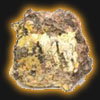
A radioactive crystal, Uranophane should be stored away from other crystals and is not a mineral to use for prolonged periods. However, under the supervision of a suitably qualified practitioner, it can support nuclear-based medicine and radiation therapy, and act as a homeopathic catalyst for releasing ancient radiation damage.
Uranophane, also known as uranotile, is a rare mineral that forms from the oxidation of uranium-bearing minerals. It is closely related to two other uranium bearing minerals cuprosklodowskite and sklodowskite, but is more common than either of them. They all form similar acicular or hair-like crystals that form radial aggregates and tufts. The color of uranophane is bright butter yellow while cuprosklodowskite is dark green and sklodowskite is a bronze to golden yellow.
Uranophane forms interesting specimens and fine specimens are sought after by collectors of rare uranium minerals. Remember, this is a radioactive mineral and should be stored away from other minerals that are affected by radioactivity and human exposure should definitely be limited.
Mineral Uranophane is usually found butter yellow to bright lemon yellow and also amber to brown that can be found more beautiful when viewed under polarizing microscope used in optical mineralogy. Uranophane is also found showing vitreous to silky luster when viewed in reflected light of petrographic polarizing microscopes for mineralogists. Most crystals of mineral Uranophane are found transparent to translucent in appearance. Uranophane is known to crystallize in the monoclinic system of crystal formation.
The crystal habit of mineral Uranophane as described in optical mineralogy typically include fibrous or acicular tufts, radial aggregates and crusts that appear more fascinating when viewed with the aid of polarizing microscopes for mineralogists.

Radiation damage.
Uranophane got its name from uran and phanos , meaning "to appear."
Notable occurrences include include Musonoi Mine, Shaba, Zaire; Bergen, Germany and Stone Mountain, Georgia and Hanosh Mine, New Mexico, USA.
